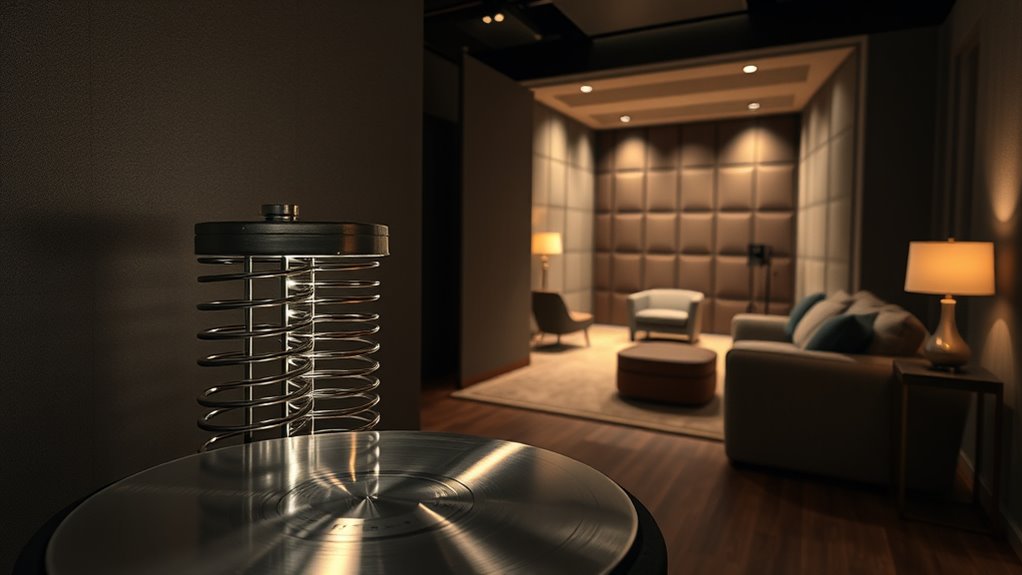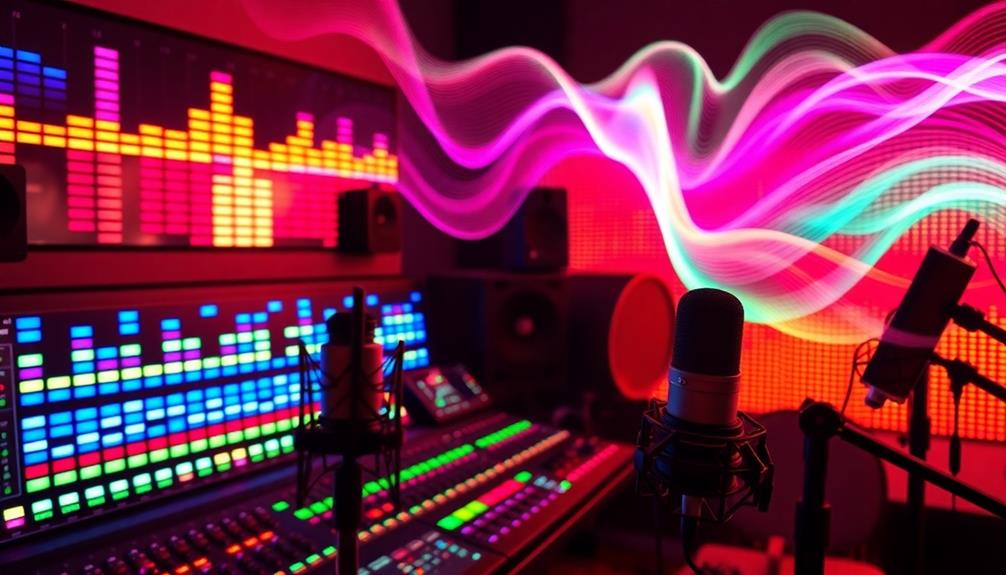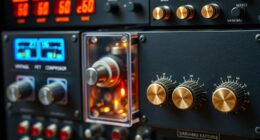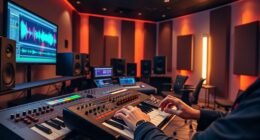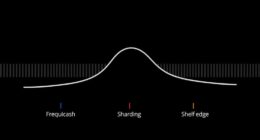Reverb types like plate, spring, hall, and room each give your sound a unique space. Plate reverb creates a smooth, bright, metallic ambiance that adds warmth to vocals and instruments. Spring reverb produces a bouncy, vintage feel, perfect for guitar and retro effects. Hall reverb mimics large concert spaces, making your sound grand and spacious. Room reverb offers a natural, intimate sense of space, ideal for vocals and drums. Keep exploring to discover how these types shape your sound.
Key Takeaways
- Plate reverb produces a dense, bright sound with a lush, metallic quality, ideal for vocals and instruments.
- Spring reverb creates a bouncy, resonant tone, often associated with vintage guitar amps and retro styles.
- Hall reverb simulates large spaces like concert halls, offering a spacious and enveloping atmosphere.
- Room reverb mimics small environments, providing natural, intimate reflections with shorter decay times.
- Each reverb type offers distinct tonal and spatial characteristics suited for different musical and production needs.
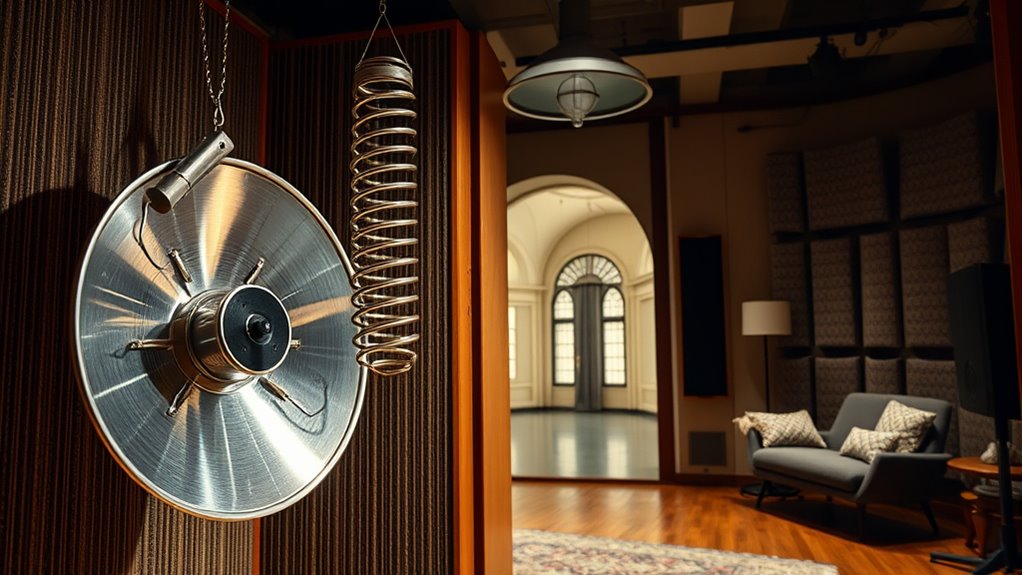
Have you ever wondered how different reverb effects can dramatically change the sound of your recordings? Reverb isn’t just about adding a sense of space; it shapes the entire mood and feel of your track. Today, digital algorithms make it easier than ever to mimic various acoustic environments, giving you the flexibility to craft the perfect ambiance. Each reverb type—plate, spring, hall, and room—has unique characteristics that suit different musical styles and production needs. Understanding these differences helps you choose the right reverb for your project, whether you’re aiming for a vintage vibe or a modern, polished sound.
Plate reverb is one of the earliest digitally simulated effects, originally created with large metal plates that vibrated to produce sound reflections. Digital algorithms now replicate this effect, capturing its smooth, dense, and bright qualities. It’s known for adding warmth and thickness to vocals and instruments, making it a go-to for genres like pop and rock. When you use a plate reverb, you’re effectively placing your sound within a lush, slightly metallic acoustic environment. It’s especially useful when you want a rich, full-bodied reverb that doesn’t muddy the mix. This type of reverb can be easily adjusted to create a more subtle or more pronounced sense of space, thanks to its predictable and controlled decay characteristics. Additionally, the efficiency and performance of digital plate reverbs allow for real-time adjustments with minimal latency, enhancing workflow during mixing.
Plate reverb simulates lush, metallic spaces, adding warmth and fullness to vocals and instruments with controlled decay.
Spring reverb, on the other hand, has a distinct, boingy character rooted in its mechanical origins. Digital algorithms now simulate the spring’s resonant qualities, which produce a bouncy, slightly metallic sound. Spring reverb is often associated with vintage guitar amps, but it also works well on vocals and drums to give a quirky, retro feel. Its acoustic environment feels more confined and lively, with a characteristic twang that stands out in a mix. Because of its unique tonal qualities, spring reverb can add a sense of character and nostalgia, making it perfect for genres that embrace vintage aesthetics or experimental sounds.
Hall reverb aims to emulate the vast, majestic spaces like concert halls and cathedrals. When you apply hall reverb, you’re immersing your sound into a large acoustic environment, which creates a spacious, enveloping atmosphere. Digital algorithms analyze the complex reflections found in real halls, allowing you to adjust the size and decay to fit your needs. This type is ideal for orchestral recordings, ballads, or any piece that benefits from a sense of grandeur. It can make vocals and instruments feel like they’re performing in a live setting, adding depth and dimension. The key is balancing decay time and early reflections to achieve a natural, immersive sound.
Finally, room reverb captures the intimate, smaller-scale acoustic environments—like a living room or small studio. It’s characterized by shorter decay times and subtle reflections, providing a natural sense of closeness. Digital algorithms simulate the reflective surfaces and dimensions of various rooms, giving you control over how much space you want to add without overwhelming your mix. Room reverb is great for bringing a natural, subtle ambiance to vocals, guitars, or drums, making them feel more present and real. It’s especially useful when you want your recordings to sound natural and unprocessed, with just enough space to breathe without losing clarity.
Frequently Asked Questions
How Does Reverb Affect Vocal Clarity?
Reverb can enhance your vocal clarity by adding space and warmth, but too much reverb density can reduce vocal intelligibility. When reverb is too thick, it overwhelms your voice, making words harder to understand. To keep your vocals clear, you should carefully control reverb levels, ensuring the reverb adds ambiance without muddying your sound. Proper reverb use helps your vocals stand out while maintaining a natural, spacious feel.
Can Reverb Be Used Creatively in Mixing?
Think of reverb as a painter’s brush, adding color and depth to your mix. You can use creative reverb applications as an effect to transform sounds into something unique and expressive. Whether you set it to create a distant echo or a lush, immersive space, reverb lets you shape your mix’s atmosphere. Don’t hesitate to experiment—reverb’s versatility opens endless possibilities for artistic, innovative sounds.
What Are the Best Settings for Live Recording?
For live recordings, you should set your reverb tail to a moderate length, ensuring it blends naturally without muddying the mix. Adjust pre-delay settings to create space between the direct sound and the reverb, which helps clarity. Start with a pre-delay of around 20-40 milliseconds and tweak based on the instrument or vocal. Keep the reverb subtle but present to enhance the live feel without overpowering the performance.
How Do I Choose the Right Reverb for My Genre?
Imagine your music’s soul; now, choose reverb that amplifies that feeling. For genres needing intimacy, opt for short reverb decay and smaller room size, like a cozy room. If you want grandeur, increase decay and room size, creating lush, expansive soundscapes. Your choice should mirror your genre’s emotion—whether it’s the warmth of jazz or the space of ambient. Let your music’s essence guide your reverb decision.
Are Digital Reverbs Better Than Analog Ones?
Digital reverbs aren’t necessarily better than analog ones, but they offer great versatility through digital emulations of classic sounds. If you want that rich analog warmth, digital reverb can often replicate it convincingly, plus provide more control and consistency. You’ll find digital units more affordable and easier to use, making them ideal for quick adjustments. Ultimately, it depends on whether you prefer the classic tactile feel or modern convenience.
Conclusion
Now that you know about plate, spring, hall, and room reverbs, you can choose the perfect space for your sound. Whether you want a shimmering, otherworldly echo or a cozy, intimate vibe, these reverb types are your toolkit. Think of reverb as the secret ingredient that transforms a simple note into a breathtaking sonic landscape—like turning a pebble into a mountain. So go ahead, experiment and make your music unforgettable!

